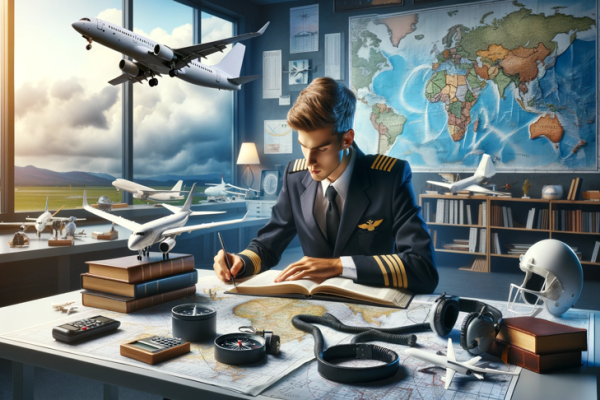Path To Become A Commercial Pilot: Steps And Requirements

Flying an aircraft is a dream come true to many, and one of the ways you can make this dream come true is by becoming a commercial pilot. Becoming a pilot helps you pursue an exciting and adventurous career, which is also one of the best-paid jobs in the aviation industry. A commercial pilot requires technical expertise, strong ethics, and a commitment to safety. But the journey to become a Commercial Pilot is not without its challenges.
Learn more about the requirements and steps required to become a successful commercial pilot.
What is required?
The prerequisites to get the aviation certification vary from country to country. In India, the Directorate General of Civil Aviation (DGCA) has laid out the requirements to become a commercial pilot. They are:
Age
The minimum age requirement for the individual to apply for the Commercial Pilot License (CPL) certification is 18 years, but they can commence their training by the time they are 17.
Educational Qualification
The applicant should have passed their 10+2 with Physics and Mathematics as the core subjects and with a minimum score of 50% in these subjects. Though these are the basic requirements, some institutions may have different requirements and preferences.
Medical Qualification
Before starting your aviation career, you must be proven physically fit. They must meet all the medical fitness criteria mandated by the DGCA. The candidates must clear the medical examination conducted by DGCA-approved authorised examiners to determine their health and prove their fitness to enter this field.
English Language Proficiency
English is the language of communication used far and wide in the aviation industry. All candidates who wish to become pilots must be proficient and fluent in English. The DGCA also conducts an English Language Proficiency (ELP) Test to test the calibre of the candidates and ensure that they are fit for this position. The ELP test includes three sections - Reading, Listening and Speaking.
How to Get Your CPL
The Commercial Pilot License is a certification issued by the DGCA, and this license will allow the candidate to act as the ‘Pilot in Command’ or as a ‘Co-pilot’ of single and multi-engine aeroplanes. Any candidate aspiring to become a commercial aircraft pilot must follow the following steps to get their pilot license.
Fulfill the Eligibility Criteria
The first step towards getting your CPL license is to fulfil everything as mandated by the DGCA. To get into flight school and get your license, you must be of the minimum age, have fulfilled the educational requirements, must be physically and mentally fit, and must have a good command of the English language.
Research about various Flight School
Once you have fulfilled all the requirements, the next step is to research and find out about the best aviation schools in the country. While choosing an aviation school, pick the one that fulfils your needs and requirements like the training procedure, the location, or the fee structure, like KAPS Academy. With limited students in each batch, our training program focuses on ensuring personal attention to each candidate, and classes are held by instructors with decades of experience in the aviation industry.
Get your Medical Certificate
Another essential step in your journey to becoming a successful pilot is to prove that you are medically fit. You must get all the required tests done by a DGCA-approved medical examiner and submit your Cass 2 and Class 1 medical certificates.
Class 1 certificate is a medical document for pilots engaged in commercial air operations. The medical standards for this certification are high. The Class 1 medical certificate requirements include eyesight, ears, psychical examination, electrocardiogram (ECG), lung function, cholesterol blood, haemoglobin blood, chest X-ray, urine, and period of validity.
This certification is valid for one year, after which the candidate must reapply for this certificate to continue their flight training and operations. To know more about medical requirements, read our blog here.
Get your other Certifications and Licenses
Before you get your CPL License, you must ensure that you have The Private Pilot License (PPL) and Multi-Engine Piston Rating (MEP). Only after acquiring these licenses and certifications will the candidate become eligible to apply for the Commercial Pilot certification.
Start with your Ground School Training
To get your certification, the candidate must apply for the aviation school and start training to gain all the required knowledge about the aviation industry. These schools or training centres cover the theoretical aspects of flight training and conduct examinations to check their calibre. The aspects of the ground school training include:
- Air Regulations - The Ground School covers the study of aviation regulations and procedures, including airspace rules, flight operations and safety protocols.
- Aerodynamics and Aircraft Systems - Ground School training delves into the principles of aerodynamics, including the operation of the aircraft, and also about various aircraft systems like aircraft engines, electrical systems and navigation instruments.
- Meteorology - As you know, weather and climate play an important role in aviation. The Ground school training also covers meteorology lessons, and the students will learn to interpret the weather charts, understand the weather patterns, and make flight plans regarding the meteorological conditions.
- Navigation and Flight Planning - Ground School Training also helps the candidates equip their skills in planning flights, calculating fuel requirements, and navigating using charts, instruments and other electronic aids.
Finish the required Flight Time
Apart from the theoretical knowledge, an individual applying for the CPL certification must have completed a certain amount of flying hours to apply for the license. They should have completed a minimum of 200 total flight hours, 100 hours as pilot-in-command, and 20 hours of cross-country flight time as pilot-in-command for about 540 km (300NM).
Complete the CPL Flight Test
Only after attending the Ground Training Classes and completing the required flight time can the candidates demonstrate their competency by sticking to the rules and regulations of the DGCA and their flight skills.